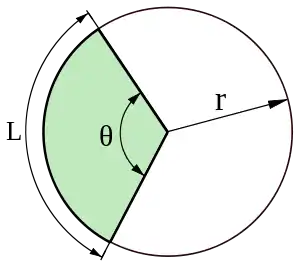Circular sector
A circular sector or circle sector (symbol: ⌔), is the portion of a disk enclosed by two radii and an arc, where the smaller area is known as the minor sector and the larger being the major sector.[1]:234 In the diagram, θ is the central angle, the radius of the circle, and is the arc length of the minor sector.

A sector with the central angle of 180° is called a half-disk and is bounded by a diameter and a semicircle. Sectors with other central angles are sometimes given special names, these include quadrants (90°), sextants (60°) and octants (45°), which come from the sector being one 4th, 6th or 8th part of a full circle, respectively. Confusingly, the arc of a quadrant can also be termed a quadrant.
The angle formed by connecting the endpoints of the arc to any point on the circumference that is not in the sector is equal to half the central angle.[2]:376
Area
The total area of a circle is πr2. The area of the sector can be obtained by multiplying the circle's area by the ratio of the angle θ (expressed in radians) and 2π (because the area of the sector is directly proportional to its angle, and 2π is the angle for the whole circle, in radians):
The area of a sector in terms of L can be obtained by multiplying the total area πr2 by the ratio of L to the total perimeter 2πr.
Another approach is to consider this area as the result of the following integral:
Converting the central angle into degrees gives[3]
Perimeter
The length of the perimeter of a sector is the sum of the arc length and the two radii:
where θ is in radians.
Arc length
The formula for the length of an arc is:[4]:570
where L represents the arc length, r represents the radius of the circle and θ represents the angle in radians made by the arc at the centre of the circle.[5]:79
If the value of angle is given in degrees, then we can also use the following formula by:[3]
Chord length
The length of a chord formed with the extremal points of the arc is given by
where C represents the chord length, R represents the radius of the circle, and θ represents the angular width of the sector in radians.
See also
- Circular segment – the part of the sector which remains after removing the triangle formed by the center of the circle and the two endpoints of the circular arc on the boundary.
- Conic section
References
- Dewan, R. K., Saraswati Mathematics (New Delhi: New Saraswati House, 2016), p. 234.
- Achatz, T., & Anderson, J. G., with McKenzie, K., ed., Technical Shop Mathematics (New York: Industrial Press, 2005), p. 376.
- Uppal, Shveta (2019). Mathematics: Textbook for class X. New Delhi: NCERT. pp. 226, 227. ISBN 81-7450-634-9. OCLC 1145113954.
- Larson, R., & Edwards, B. H., Calculus I with Precalculus (Boston: Brooks/Cole, 2002), p. 570.
- Wicks, A., Mathematics Standard Level for the International Baccalaureate (West Conshohocken, PA: Infinity, 2005), p. 79.
Sources
- Gerard, L. J. V., The Elements of Geometry, in Eight Books; or, First Step in Applied Logic (London, Longmans, Green, Reader and Dyer, 1874), p. 285.
- Legendre, A. M., Elements of Geometry and Trigonometry, Charles Davies, ed. (New York: A. S. Barnes & Co., 1858), p. 119.